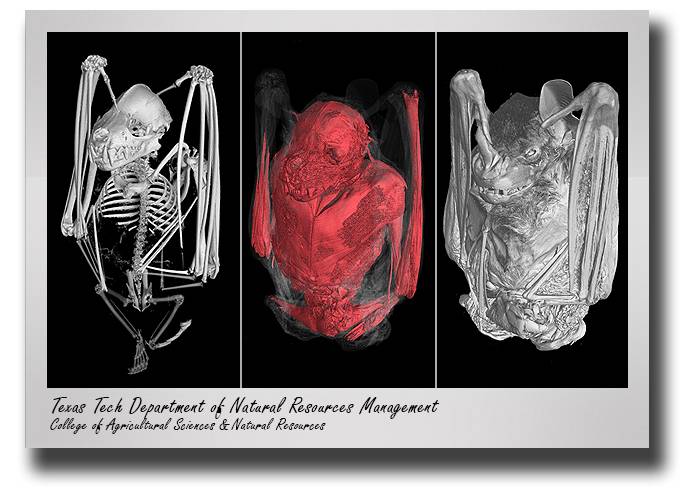CT Scan-based NRM project focuses on ecologically important bat species
By: Norman Martin
 A Texas Tech University research team recently received a $175,000 grant from the
National Science Foundation to begin three-dimensional digitization of a special group
of bat specimens from the university’s massive Natural Science Research Laboratory.
Part of the project’s goal is to make this newly input digital data freely available
to almost anyone with an internet connection.
A Texas Tech University research team recently received a $175,000 grant from the
National Science Foundation to begin three-dimensional digitization of a special group
of bat specimens from the university’s massive Natural Science Research Laboratory.
Part of the project’s goal is to make this newly input digital data freely available
to almost anyone with an internet connection.
 Richard Stevens, Texas Tech’s President’s Excellence in Research Professor in the College of Agricultural
Sciences and Natural Resources, and Robert Bradley, a Professor in Tech’s Department of Biological Sciences, are set to CT Scan 1,000
bat specimens from one of the most diverse families of bats in the world - Phyllostomid
bats. The bats are distributed from Texas and the southwest United States south to
Paraguay and Argentina.
Richard Stevens, Texas Tech’s President’s Excellence in Research Professor in the College of Agricultural
Sciences and Natural Resources, and Robert Bradley, a Professor in Tech’s Department of Biological Sciences, are set to CT Scan 1,000
bat specimens from one of the most diverse families of bats in the world - Phyllostomid
bats. The bats are distributed from Texas and the southwest United States south to
Paraguay and Argentina.
“These bats are one of, if not the most, ecologically diverse groups of mammals and play important roles in the ecosystems they help form,” Stevens said. “They impact many populations of insects, and maintain and restore forest systems through plant pollination and seed dissemination.”
Because of their importance, species from this family are studied by hundreds of scientists across the globe. “Not only will digitization of specimens improve access, but it will also facilitate much more resolved scientific inquiry into the biology of these bats,” added Bradley, who also serves as Director and Curator of Mammals at Tech’s Natural Science Research Laboratory.
A key driver of the important ecosystem services provided by phyllostomid bats is the tight relationship between form and function, Stevens said. A more resolved understanding of ecomorphological relationships of these bats can provide insights into their positive economic impacts through the ecosystem services they provide, how this has evolved and how this may change in the future with changing environments.
 For entire systems to function sustainably and be maintained in perpetuity, conservation
efforts focus on the many non-game species that comprise contemporary ecosystems.
A critical tool for conservation of entire systems are natural history collections.
These collections are clearinghouses of information on the contemporary and historical
distribution and abundance of organism, both game and nongame.
For entire systems to function sustainably and be maintained in perpetuity, conservation
efforts focus on the many non-game species that comprise contemporary ecosystems.
A critical tool for conservation of entire systems are natural history collections.
These collections are clearinghouses of information on the contemporary and historical
distribution and abundance of organism, both game and nongame.
 Natural history collections offer a window into the past and are extremely valuable
for determining differences between historical and contemporary records of distribution
that allow understanding as to how ecosystems have changed through the years. This
is especially important now given ongoing climate change to answer questions such
as whether historical ecosystems are actually different than in the past, and if so,
how.
Natural history collections offer a window into the past and are extremely valuable
for determining differences between historical and contemporary records of distribution
that allow understanding as to how ecosystems have changed through the years. This
is especially important now given ongoing climate change to answer questions such
as whether historical ecosystems are actually different than in the past, and if so,
how.
Texas Tech’s Natural Science Research Laboratory Mammal Collection has approximately 150,000 scientific specimens and 500,000 tissue samples. It has particularly good representation regionally across much of Texas and the southwestern United States, as well as across much of North and South America and the Caribbean.
CONTACT: Richard Stevens, President's Excellence in Research Professor and Professor of Natural Resources Management, College of Agricultural Sciences and Natural Resources, Texas Tech University at (806) 834-6843 or richard.stevens@ttu.edu
0907NM21
Davis College NewsCenter
-
Address
P.O. Box 42123, Lubbock, Texas 79409-2123, Dean's Office Location:Goddard Building, Room 108 -
Phone
(806)742-2808 -
Email
kris.allen@ttu.edu
